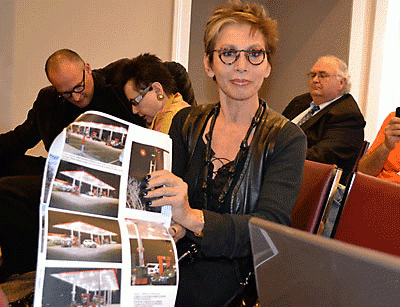Rivers ‘Legs’ Must Walk, Sag Board Rules

“We’re not deciding what is art,” Gail Pickering, the chairwoman of the Sag Harbor Village Zoning Board of Appeals, said Tuesday night after the board voted to deny Janet Lehr and Vered’s application to keep a pair of 16-foot-tall “Legs” by Larry Rivers on their Madison Street property.
“Art can be both art, and a structure subject to zoning,” Ms. Pickering said, explaining the board’s decision to uphold the village building inspector’s determination that the sculpture qualifies as a structure under village code, and must either meet the required setbacks or receive variances if it does not. Upon hearing the final decision, Vered called the board “a bunch of chickens.”
“It is disgusting,” she said as she held up images of the proposed Harbor Heights gas station renovation, which shows a brightly lit canopy over the gas pumps in front of a new convenience store. “In a residential neighborhood?” she asked. “That structure is okay because it’s far enough from the road?” She was then asked to leave the room unless her discussions were relevant to the current application being heard. She and Ms. Lehr stepped outside to vent their frustrations before returning for the rest of the meeting.
“In all of the years I have been here on this board,” said Anton Hagen, the first trustee to explain his opposition, “I have never seen as much of a variance asked for.” In order to keep “Legs” where it is — one foot from their Henry Street property line — the couple needed a 34-foot variance from side-yard setbacks as well as height and pyramid law variances. “It would go against all of the other decisions I have made over 10 years,” Mr. Hagen said.
Benedetta Deubel, another board member, agreed. “I have traveled all over the world to look at art,” she said during the hearing on the application in March. “In this case it is a legal matter.”
The first thing the board needed to consider, Ms. Pickering explained Tuesday night, was whether Timothy Platt, the building inspector, was in error when he determined in January that “Legs” was an accessory structure. They decided that Mr. Platt’s decision was “rational and reasonable,” she said. The board pointed to a prior case considered similar involving a heron sculpture that Southold Town determined to be a structure. The decision in that case was aid to be a factor in the Vered-Lehr decision.
Also taken into consideration was that “several neighbors appeared before the board, vehemently opposed,” Ms. Pickering said, adding that the size, location, and light disrupt the neighbor’s enjoyment of their own properties.
Speaking at the hearing in March, Vered said that the loudest voice of opposition was that of the homeowner next door, who she said “has not lived there for 10 years. When we bought [the house], he wanted it torn down because it was old and dilapidated. We put our life and money into it. His house is for sale,” she said. Another woman, she said, “didn’t like the light. I can accommodate her. Those are the only two people that didn’t like it. Both have their houses for sale.”
The couple collected more than 500 signatures of people in favor of keeping the sculpture where it is and presented the petition to the board last month along with 120 e-mails and letters of support. “There is no such thing as one size fits all,” Vered said at the time. “Every case has to have its own merits.”
“Dimension requirements are the issue here,” Ms. Pickering said Tuesday, adding that it is “clearly an undesirable change to the neighborhood.”
“If they were looking for a foot or two feet . . . but it seems like an enormous undertaking to give them a variance,” Brendan Skislock, another board member, said in explaining his no vote.
The board’s attorney suggested giving Vered and Ms. Lehr 60 days to remove the sculpture, Ms. Pickering proposed instead that the sculpture be allowed to remain until Sept. 15.
With the exception of Michael Bromberg, who recused himself from the application, the trustees unanimously agreed.
Later in the meeting, Mr. Skislock had an application of his own before the board. He and Vincent Frezzo requested a variance for an in-ground swimming pool to be built within 27 feet of their front lot line, where a minimum of 35 feet are required, and 27 feet from a wetland boundary, where a minimum of 75 feet is required. Mr. Skislock recused himself from deliberations.
Vered spoke in opposition. “I know that Mr. Skislock is one of the members of this committee. I hope that will not work to his advantage,” she said, then asked, “Do you have the jurisdiction to decide on distance from wetlands? Did he get permission?”
Ms. Pickering explained that “since the property is bulkheaded, the [Department of Environmental Conservation] jurisdiction disappears.”
The application has not been publicly heard by the Harbor Committee, which must approve it, but it has been put in their hands, according to Dennis Downs, an attorney representing Mr. Skislock. The lawyer said that Richard Warren, the village’s environmental consultant, had reviewed the application and made a number of requests including a drywell. Mr. Skislock’s property is pre-existing and nonconforming, with 1,946 square feet of wetlands. Mr. Downs said a cited “Eco-smart pool filtration system” is planned and that the septic system will be moved from the rear to the front yard, farther from wetlands.
“I have been inclined to approve it,” Mr. Hagen said. “I think the Harbor Committee looked at this. I don’t think I want to argue with them as far as protecting the wetlands.”
Mr. Bromberg agreed, “I think this meets our criteria, no matter what the Harbor Committee says.”
When the board unanimously approved the application, Vered yelled “Surprise!” and left the room.
